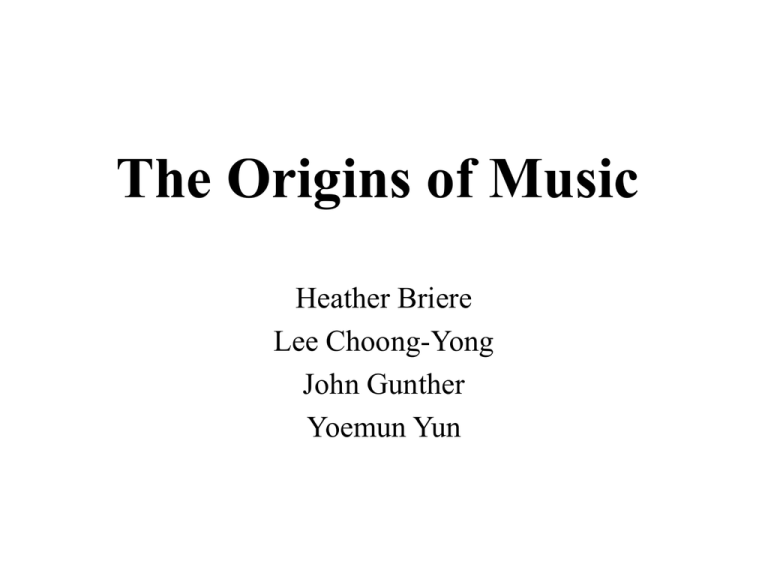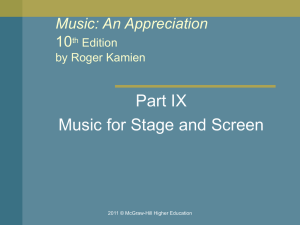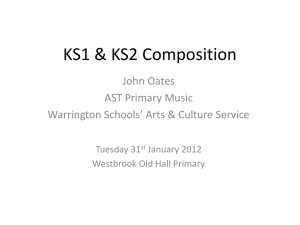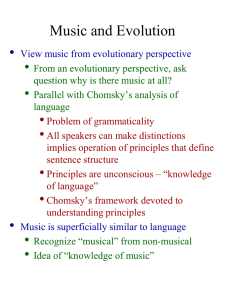The Origins of Music
advertisement

The Origins of Music Heather Briere Lee Choong-Yong John Gunther Yoemun Yun • Music offers important insight into the study of human origins and human history in at least three principal areas. • Evolutionary Musicology- using music to study human origins and human culture 1. Music is a universal and multifunctional cultural behavior. 2. Music and language share many underlying features – – – – – – Evolution of the human vocal tract The hominid brain expansion Human brain asymmetry Lateralization of cognitive function The evolution of syntax Evolution of symbolic gesturing 3. Music can contribute to a study of human migration patterns and the history of cultural contacts. Biomusicology Major Issues in Evolutionary Musicology 1. The question of animal song - “What is music?” “There is no a priori way of excluding the possibility that our distant forbears might have been singing hominids before they became talking human, and if so, that hypothetical fact would surely have some bearing on the way we approach the question of the origin of music.” 2. Music evolution versus language evolution – – Many connections exist between music and language at the structural level. Three possible interactive theories for the evolution of music and speech • • • Music evolved from speech Speech evolved from music Both evolved from a common ancestor 3. Selection Mechanism for music – – What is music for? Under what conditions did it evolve? 4. The evolution of meter – – The human ability to keep time is distinguished from the ability of most animals (including humans). Humans have unique ability to entrain their movements to an external timekeeper (drums). 5. Absolute Pitch – – – – – Genetics Cultural exposure Learned at a young age In non-musicians In animals 6. Music Universals “…provides a focus on the unity that underlies the great diversity present in the world’s musical systems, and attributes this unity to neural constraints underlying musical processing.” Examples of universal musical aspects: 1. Octaves are perceived as equivalent in almost all cultures 2. Virtually all scales of the world consist of seven or fewer pitches per octave 3. Most of the world’s rhythmic patterns are based on divisive patters of two’s and three’s 4. Emotional excitement is universally expressed through loud, fast, accelerating, and hugh registered sound patterns Methods in Evolutionary Musicology • The comparative methods and analysis of animal song – Acoustic analysis of song – Neurobiological analysis of song production and perception – Behavioral-ecological analysis of singing behavior and it’s associated displays • Physical anthropology and musical archeology • Music-language comparative analysis • Human brain imaging • Comparative musicology Music Evolution: Biological versus Cultural • Looks at music from the standpoint of cultural evolution and tries to tie it in with the biological evolution of musical capactiy during hominid evolution • Darwinian theories of culture • Musical classification and history • In a study by Alan Lomax of over 4,000 songs from 233 different cultures, he was able to classify the performance styles into 10 basic categories. From this study he further hypothesized a kind of musical language tree with two evolutionary rootsone in east Asia and one in sub-Saharan Africa. Vocal Communication in Animals Music, Language, and Human Evolution Theories of Music Origin Neurobiological Role of Music in Social Bonding Walter Freeman An exploration in the role of music as an instrument of communication beyond words as a way in which humans come to trust one another. How and why, in biological terms, can music and dance bring humans together with a depth of bonding that cannot be achieved with words alone? The Biological Dynamics of Perception The mechanisms of the ear that transform sounds to neural messages and the pathways that carry messages to the auditory cortex are well understood. What's less understood is what happens afterwards. Some of what has been observed: The information is processed through neighboring cortical areas concerned with speech and music. • Exchanges occur between parts of the "newer" brain and older parts of the fore brain. • Experiments have shown brain activity continuing after stimulus has ceased. An experiment traced the path in brains of rabbits from an odor stimulus. After transmission to the cerebral cortex, stimulusdependent activity vanished. What appeared in place were new patterns of cortical activity. This phenomena was also observed in the visual and auditory systems. In all these systems, traces of the stimuli were replaced by new patterns of neural activity. Evidence finds this same principle holds for all sensed in all animals including humans. The conclusion: The only knowledge that animals and humans can have of the world outside themselves is what they construct within their own brains. Biological Isolation of Brains from Each Other These experiments indicate that all knowledge is created within the brains of individuals. • • • If true, how can a mind really be sure that any other mind exists or for that matter the world? How can knowledge of natural laws and mathematics emerge? If knowledge is expressed in a private language within each mind, how can it be shared and verified as being the same in different minds? Philosophers call this Solipsism where everything that exists is the projection of a brain. Repeated attempts to answer these questions by logic and computation have not succeeded. The problem lies in establishing mutual understanding and trust through shared actions during which brains create the channels, codes, agreements, and protocols that precede reciprocal exchange of information in dialogues. “It takes more than a telephone line and a dictionary to make a call to a foreign country.” Selected Neuropeptides Dissolve the Solipsistic Barrier Music has the power to induce and modulate different emotional states and these states are accompanied by the release of neurohormones. Other activities in which the release of neuropeptides can be observed in brain function include copulation to orgasm in males and females and in female lactation. The neuropeptides appear to dissolve pre-existing learning by loosening the synaptic connections in which prior knowledge is held. This opens the opportunity for learning new knowledge, understanding, and trust This process of transformation has also been observed in the experiences of: Brainwashing, Dancers in preliterate tribes, and parishioners involved in intense religious conversion. In all experiences, the person has undergone severe sensory overload. This “brain in crisis” is followed by a state of malleability and opportunity for reeducation, providing an opportunity for the formation of allegiance and trust. Music and Dance as the Biotechnology of Group Formation Anthropologists and ethnopsychiatrists have documented the prevalence in preliterate tribes of singing and dancing to the point of physical and psychological collapse during religious and social ceremonies. The same neurochemical mechanisms that evolved to support sexual reproduction and the formation of allegiance and trust, appear to be triggered by the experience of intense singing and dancing, producing a feeling of belonging and bonding among the participants. Biocultural Evolution of Music in Socialization Here in its purest form is a human technology for crossing the solipsistic gulf. It constructs the sense of trust and predictability in each member of the community on which social interactions are based. A siginificant discovery by our remote ancestors may have been the use of music and dance for bonding in groups larger than nuclear families. This would be valuable for survival. Music can be observed today bonding people together worldwide, particularly young people. Universals in Music “Human Processing Predispositions and Musical Universals” By: Sandra Trehub • Long-term exposure to the music of a particular culture is largely responsible for adults’ implicit knowledge of music. • Children exhibit better perception and retention of music with increasing age. • Adults and children show superior memory for melodies that are structured in conventional rather than unconventional ways. • Formal music training is associated with enhanced perception and retention of music by children as well as adults. • Nevertheless, basic principles of auditory pattern perception may still lie at the heart of mature music processing. • Do the similarities stem from processing predispositions that are common to all members of the species or from long-term exposure to similar kinds of music? • If this were true, music from different cultures could be expected to share some fundamental properties that make it discernible and memorable, perhaps even appealing. The Experiments • Trehub and her colleagues studied infants’ perception of music or music-like patterns. • Melodies consisted of sequences of pure tones (sine waves). • Trehub ascertained which features of a melody are salient and memorable for such naïve listeners – Six- to nine-month-olds were presented with repetitions of a melody sounding from a loudspeaker at one side, and were rewarded with an interesting visual display from responding (by turning to the loudspeaker) to specified changes in melody. • These procedures revealed that infants’ perception of music-like patterns is remarkably similar to that of adults. Relational Processing of Auditory Patterns • After listening to a brief, unfamiliar melody, adults generally remember little more than its melodic contour and rhythm. • If infants hear a melody which is subsequently transposed (with all intervals between notes unchanged) they treat the transposition as equivalent to the original melody. • In contrast, a change in contour resulting from the substitution of a single tone or the reordering of tones leads infants to consider the altered melody as unfamiliar, much like adults. • Therefore, the pitch contour of a melody seems to be central to its identity. Rhythm also makes important contributions to the identity of a pattern. • Infants consider faster or slower versions of a tone sequence as functionally equivalent, provided the rhythm or temporal pattern remains unchanged. It is also clear that infants group or chunk components of tone sequences on the basis of similar pitch, timbre, or loudness in much the same way as adults. – Infants detected a pause inserted within a group of similar tones easier than between groups of tones. Therefore, one can propose three processing universals: 1. The priority of contour over interval processing 2. The priority of temporal patterning over specific timing cues 3. The relevance of gestalt principles of grouping • • All of these principles involved a priority for global, relational cues over precise, absolute cues. It is interesting that this contrasts with nonhuman species, for they focus on absolute pitch details in auditory sequences. Interval Processing: Frequency Ratios • Infants’ ability to perceive invariant contour and rhythm across changes in individual pitches and durations is not confined to music, but also to spoken patterns. • Other adult-infant similarities, such as a sensitivity to small-integer frequency ratios, are more specifically linked to music. Ancient and medieval scholars claimed that tones related by small-integer ratios are pleasant, or consonant, and that those related by large-integer ratios are unpleasant, or dissonant. • Infants and adults show better retention of melodic intervals of perfect fifths and fourths than tritones. • Infants and adults tend to categorize intervals on the basis of consonance or dissonance rather than size. • Also, they more easily detect a change from a consonant harmonic interval to a dissonant interval than to another consonant interval. • In short, the priority of small-integer over lateinteger frequency ratios can be considered another processing universal. Scale Structure • Despite variations of scale structures of different cultures, they are all very similar. • They all tend to have 5-7 pitches per octave • Specific intervals tend to predominate, notably small-integer ratios • Scales incorporate variations in step size • Unequal-step scales are thought to confer processing advantages, such as allowing different tones to assume distinctive functions, facilitating the perception of tension and resolution, and providing the listener with a sense of location within a melody. • Infants and adults were presented with transposed repetitions of three ascending-descending scales. – An equal-step scale – The major scale – An unequal-step scale • For each scale, infants were required to detect a three/four-semitone change in one tone. Adults had to detect a one/two-semitone change in one tone. • It was no surprise that adults performed better on the familiar major scale than on either unfamiliar scale. • Infants performed significantly better on both unequal-step scales than on the equal-steps scale. • Therefore, exposure could then be ruled out as a factor contributing to performance differences. These findings are consistent with the view that unequal-step scales have their origin in perceptual processing predispositions, but they also indicate the potency of culturespecific exposure. There is a definite priority for unequal over equal steps in scales, which can be considered another processing universal. Rhythmic Structure • The diversity of rhythmic structures across cultures makes it easy to imagine that musical rhythms have their foundation in culture rather than in nature. • It has been proven that infants perform better on rhythm changes than pitch and rhythmic changes, and adults prefer a natural bias for certain rhythm, which suggests a natural bias for certain rhythmic forms. Lateral Asymmetric in Processing • Asymmetries in brain structure and function are evident from the earliest days of life. • In dichotic listening tasks, infants generally exhibit the characteristic right-ear (left hemisphere) advantage for speech and left-ear (right hemisphere) advantage for music. • Adults show a left-ear advantage for contour processing and a right-ear advantage for interval processing. However, when infants are reexamined at 8-months-old, they show the same results as the adults. Implications of Adult-Infant Similarities • Infant listeners with minimal exposure to music and adult listeners with extensive exposure make a compelling case for “inherent learning preferences.” Speech and Sign for Infants • Caregivers everywhere enhance their vocal messages to prelinguistic infants by making them more musical than usual.These caregivers use: – – – – – Specific pitch contours Articulate words poorly Raise their pitch level Slow their tempo Make utterances more rhythmic and repetitive Music for Infants • The lullaby is a distinct genre of song with it’s slow tempo, simplicity, repetitiveness, and a preponderance of falling pitch contours. • When a mother sings the same song first directly to their infants, and then once in the infant’s absence, both adults and infants can hear the difference. This is because vocal adjustments are unconsciously made to enhance the emotional expressiveness when the mother sings to directly to her child. Infants’ Responsiveness to Infant-Directed Music Do particular song types and styles of performance make any difference to the infant audience? – Infants prefer the lullaby song form. – Infants prefer the performer to be a woman. – Infants prefer the infant-directed performing style. Conclusions • Trehub has proven the following universals to be true when it came to both adults and infants: – Greater emphasis on global features than local details – The prevalence of small-integer frequency ratios, unequal scale steps, and preferred rhythms – The existence of a special genre of music for infants (the lullaby) • Thus, the findings from these experiments show that there is a biological base for some music principles. “The Question of Innate Competencies in Musical Communication” By: Michel Imbery Gestaltism • • • “The whole is greater than the sum of its parts.” The analogy between language and music naturally makes one think about the work of Lerdahl and Jackendoff and their Generative Theory of Tonal Music (GTTM). When we apply the GTTM to cognitive theories of language and music, three postulates form: 1. Specific capacities or competences, for language on the one hand, and for music on the other are describable in terms of grammars. Musical competences constitute a set of aptitudes or innate capacities that depends very little on particular conditions of concrete training during childhood and adulthood. 2. There are musical and linguistic universals that characterize human thought. 3. These grammatical systems should have their equivalent in the internal functioning of the brain, which means that the competencies correspond to defined and independent neuronal systems. Universality and Innateness Rameau once wrote, “Music is natural to us; we owe the sentiment that it makes us feel to pure instinct; this same instinct acts in us with many other objects which can very well be related to music.” Two difficulties arise to define the scope of innateness in the case of musical competence: 1. Musical competence seems to be reducible to the capacity to produce variations on prototypical schemas without possible limitations or recurrences. 2. The innateness of musical competence is knowable only through induction in terms of the universality of these prototypical schemas, thus suggesting that production processes are not as primary as they are in language. The Question of Atonal Music “The General Theory of Tonal Music is based on the hypothesis of certain equivalence between the musical piece’s structure as it is described and the psychological need for hierarchical organization in perception and memory, as well as emotional dynamics.” Lerdahl formulated a new proposal (based on Schoenberh’s pieces) that in atonal music, prolongation structures are structures of the hierarchical organization of salience. They are those sounds that immediately catch one’s attention. Dynamic Aspects of Salience Clues and the Concept of Macrostructure • How can salience create the equivalent of alternations of tension and relaxation that make up the emotional dynamism of tonal music? – A simplified schema is formed and an imprint stored in memory – Perceptual organization is founded on temporal phenomena • A piece of music is an ordering of auditory events in time, and the macrostructure is a simplified schema, a priori an ordering that is filled later by concrete auditory events of which the progression for the listener is thus more or less predictable. • Michel Imberty concludes that “music plays on representations and fantasies that are created by experiences of temporal feelings in human life, between continuity and discontinuity, between fusional unity and fragmentation, and between mobility and immobility. The individual psychology of time is built upon interactions with others. Music takes its power in its profoundly social nature, like language, as a vehicle of interiorized representations.” “An Ethnomusicologist Contemplates Universals in Musical Sound and Musical Culture” By: Bruno Nettl Nettl believes we can look at the world of music in terms of musical languages and social units, where each has its own “music.” Universality of the Music Concept “One problem with using universals as a guide to discovering the origins of music is the difficulty in defining music in a way that is equally valid for all cultures and societies. The world’s cultures vary in the degree to which they have the concept of music and in the value and function they assign to it.” Music is not easily defined when it comes to ethnomusicology and exploring the origins of music. This leads one to ponder: – Do all societies have a kind of sound communication that they distinguish from ordinary speech? – Where do we draw the line? Universals • “Musicness” is separate from “speechness” • Music is a transforming experience – Music provides some kind of fundamental change in an individual’s consciousness or in the ambiance of a gathering – Examples: music used to mark the importance of an event, and music is also virtually universally associated with dance • “The world’s simplest style” – Music in almost every culture consists of songs that have a short phrase repeated, with minor variations, using three or four pitches within a range of a fifth. Nettl concludes that “…universals do exist in musical sound and in musical conceptualization and behavior. Those that involve musical style are at best statistical, but they might tell us something about the earliest human music.” “The Necessity of and Problems with a Universal Musicology” By: François-Bernard Mâche Mâche believes that the invention of the taperecorder changed the way we think about music, for it allowed people to record and later listen to the recorded “music.” • Without the taperecorder, we would possibly have missed the fact that the tonal system can no longer be considered to be universal. • Without recordings we would also have much poorer knowledge of animal sound signals, since we would be forced to rely on our memory in order to compare and analyze “music.” • Whether it be good or bad, the taperecorder made it easier for cultures to imitate each other and yield a worldwide uniformity. • Many practices testifying to the cultural diversity are no longer available outside the archives where taperecorders allowed the freezing of their sounds. Ethnomusicology developed as a new approach to the music of the world, and pointed out that even the phenomenon of music itself could be properly understood only if considered from the inside. • The invention of ethnomusicology created extreme cultural relativism, through its focus on every individual musical culture. • It claims that no culture has any right to superimpose its categories on any other, for it tends to favor a kind of reverse racism by isolating every culture from all others, while the blending of musical practice becomes unintelligible. • Mâche differed slightly from ethnomusicologists. Mâche believed the main problem was to understand how precise sound organizations can be inscribed in every brain, and how musical choices emerge from them or deal with them. • Mâche’s goal was to understand how and why cross-cultural features are met everywhere in music, even if no universal definition of what music is has yet been agreed upon. In trying to do so, Mâche came up with a series of sampled universal features given by nature in music, by illustrating several similarities between animal and human signals. 1. Pentatonic polyphony of a drone (limited to humans) • Examples: Folk songs from Albania, the Gerewol song of the Peuls Bororo of Niger, and the music of the Paiwan aborigines of Taiwan 2. An important family of rhythms among different musical systems is the aksak. They oppose an irregular number of basic units, grouped by two and by three. Sometimes, a song is rhythmically organized as a whole, meaning that the animal (example: bird) may have an overview of a very long duration. • Example: In both the “Turtur Brehmeri”(song of a blue headed dove) and “Sarothrura Lugens”(song of the chestnut-headed pygmy rail) one can see a universal link among accelerando, crescendo, and rising in pitch. 3. The occurrence of a set of discrete pitches (Music is claimed to begin with the invention of a scale) • Examples: Many mythic traditions, in Greece and China attribute this creation to a god or a cultural hero. Many animals also use precise and stable sets of pitches in their signals. 4. The evidence for a hierarchy between the degrees of a scale • Examples: The tonic and dominant in human tonal systems. The songs of the white-browed scrub robin also have a keynote that appears at the end of each stanza. 5. The process of transposition • Examples: The song of the white-handed gibbon gets transposed whenever a sound is imitated by another gibbon whose sound does not fit in the range of the imitator’s voice. 6. The process of imitation • Examples: Refrains, rhymes, symmetry, and reprises are common in many animal’s songs. Mâche concluded that the idea of a gratuitous aesthetic pleasure is but a very small part of musical behavior in humans, and that it did not become all that important until one or two centuries ago in Europe. Many cultures have no idea what a concert is! Instead, many cultures make music only in ritual contexts. Mâche also concluded that social singing between neighboring males has been repeatedly reported, thus there is an intrinsic pleasure in singing. The luxurious display of some of the best singers, no matter their species, suggests that they go far beyond the signals that would be necessary for keeping a territory or mating. http://homepages.nyu.edu/~hmb249 Reference For The Preceding Findings: Origins of Music (2000) Wallin, Merker, & Brown eds. Cambridge: The MIT Press.








